Website Colors
Share this on...We have done our very best to represent the actual finishes of our frames so that the product you receive will closely match what you see displayed on our website. However, there are some reasons why you might see slight variations.
HAND-FINISHED TOLERANCES
- Due to the hand-finished nature of the product, there is some tolerance for finishes to vary between shipments.
LIGHT SOURCES (...when viewing a frame in person)
WHAT IS LIGHT?
Light is electromagnetic radiation (EMR) comprised of photons that travel outward in all directions at the speed of light in wave-like patterns. EMR is measurable in frequencies, wavelengths or energy. (Note: These three independent methods for measuring EMR correspond with each other.) The electromagnetic spectrum, as the continuous range of EMR is known, is divided into seven types: Gamma rays, X-rays, ultraviolet, visible light, infrared, microwaves and radio waves.

WHAT IS COLOR?
There is an ongoing debate on the realism of color in the visible world. The traditionally mainstream theory is that color perception is a phenomenon that takes place within the brain. Visible light enters the eye and is captured by photoreceptors (light-sensitive cells) in the retina called cones and rods. As the light photons reach the cones and rods, they are absorbed, and their energy causes a chemical reaction which generates an electrochemical signal. The signal is transmitted through the optic nerve to various parts of the brain for processing. The visual centers of the brain (e.g., visual cortex) reconstitute those signals into images, scenes, and color, hence providing us our perception of the world that physically surrounds us. Physical matter itself does not contain a "color" property; instead it emits, reflects or absorbs EMR. Color occurs solely inside the mind. (Note: The following CIE diagrams are 2D mathematical representations of the full range of human color perception. The graph coordinates and plotted curves are mathematically accurate, but because no display device is yet capable of displaying the whole gamut of colors visible to humans, the colors in the diagrams are best approximations and are for reference only.)
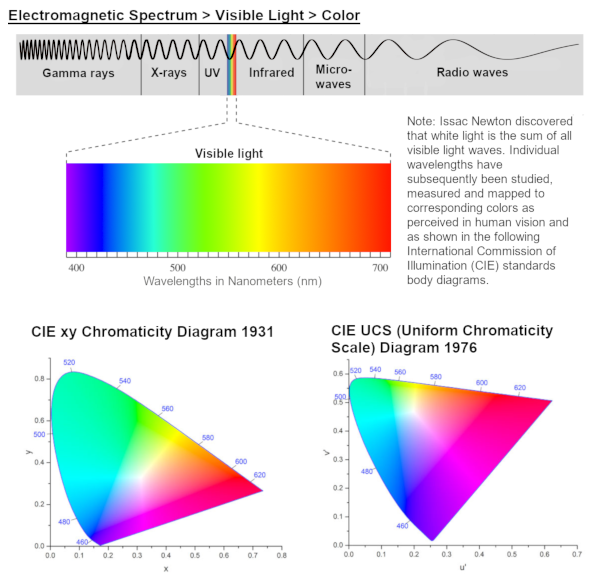
HOW DO DIFFERENT LIGHT SOURCES EFFECT OUR PRECEPTION OF COLOR?
Visible light sources are not all created equal and can vary in their ability to illuminate and render the color of an object. You have probably purchased a light bulb that was advertised as "warm white," "natural white," "day white" and "cool white" among others. Those descriptions refer to the color of light that the light source emits. "Warmer" lights (e.g., Incandescent and Halogen) trend toward the infrared spectrum and give off a yellow-orange color. "Cooler" lights (e.g., CFL and LED) trend toward the ultra-violet spectrum and give off a blue color.
The color of light is defined using a Correlated Color Temperature (CCT) scale represented in degrees Kelvin. CCT ratings are not a measurement of the actual thermal temperature of the lightwave; instead the range is a "correlated" temperature based on the study of Blackbody Radiation. The sun is the reference standard that is used as the ideal Blackbody Radiator because it is the primary source of light in our solar system. (If you want to understand the history and development of the Correlated Color Temperature scale you can research Blackbody Radiation and Planck's Law.) The following diagram, based on Planck's Law, lists various light sources and corresponding CCT ranges. The second diagram shows the CCT scale (also called Plank's Curve) plotted on the CIE Chromaticity Diagrams of 1931 and 1976.
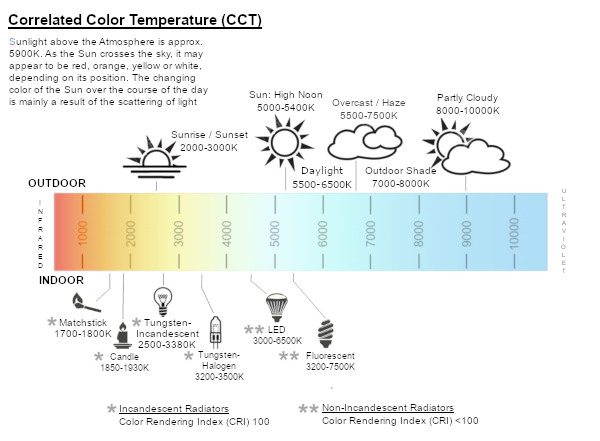
WHAT IS SPECTRAL POWER DISTRIBUTION?
The second component affecting accurate color rendering is the Spectral Power Distribution (SPD) of the light source at its CCT. An official definition of SPD by the Illuminating Engineering Society of North America (IESNA) is, "A pictorial representation of the radiant power emitted by a light source at each wavelength or band of wavelengths in the visible region of the electromagnetic spectrum (360 to 770 nanometers)". What this means is you can have two different light sources, each rated at the same CCT, yet both can render the colors of an object differently depending on their SPD. The lower the SPD at a given wavelength the poorer that particular color will appear. Below are some random examples of different light sources and their associated SPD readings. Notice how the sun has power distribution across the entire visible light spectrum as compared to a random selection of artificial light sources.
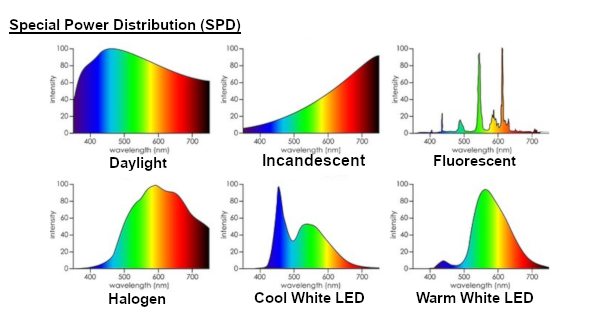
HOW IS SPECTRAL POWER DISTRIBUTION RATED?
An official rating system is known as the Color Rendering Index (CRI) is used to quantify the SPD of a given light source. (Full-Spectrum Index (FSI), Full-Spectrum Color Index (FSCI) and Gamut Area (GA) are other color rendering metrics.) CRI is measured using a scale from 0 to 100, the higher numbers representing better color rendering capability. Fifteen test colors are sampled, labeled R1 through R15. The sum of the results for R1 through R8 are averaged, and the value becomes the CRI of the light. Test colors R9 through R15 are supplemental colors that were recommended for inclusion in the rating standard but were never officially added. However, most manufacturers test these additional colors and include the results in their marketing literature.
Direct sunlight at noon is rated CRI 100. A light source should have a CRI of 90 or above to be considered capable of accurate color rendering, and high CRI light sources are often called "Full-Spectrum" lights. Incandescent and Halogen light sources typically rate at CRI 100; however, the color temperature of the light (typically between 2500-3500K, in the "warm white" range) add a tint that can be very subjective to the viewer, even though the objects colors fully rendered. LED's, CFL's, Flashes and HID's have a CRI anywhere between 0 and mid-'90s and can suffer the same viewer subjectivity at the cooler end of the spectrum.
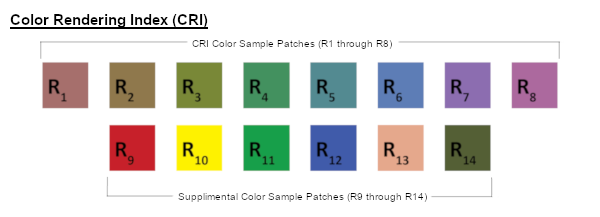
WHAT IS LUMINESCENSE AND HOW DOES IT EFFECT COLOR RENDERING?
The third component affecting color rendering is Luminescence, also known as the light intensity that is falling on the object surface, expressed as the "lux" or "foot-candle" value. (1 foot-candle = 10.764 lux) In 1941, a Dutch researcher, Arie Kruithof, published a graph (Kruithof Curve) illustrating the relationship between color temperature, light intensity, and the "pleasant" quality of a light source.
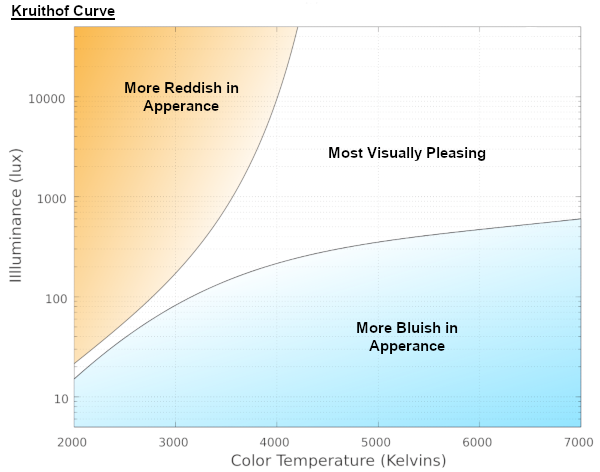
DISPLAY TYPES (...when viewing a frame on an electronic device)
- Due to the variable display types and video settings that are available on smart-phones, tablets, laptops and desktop computers we cannot guarantee that what your device displays will exactly match the frame finish.
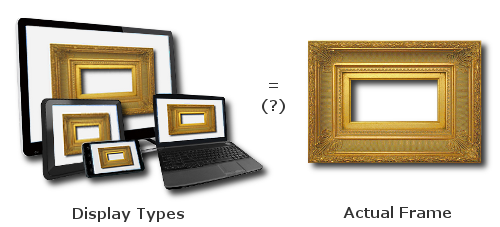
PAINTING FRAMES PLUS PRODUCT PHOTOGRAPHY SETUP and EQUIPMENT
- We have no control over the equipment (above listed factors) that our visitors use to view our frames online, however, we do have control over the product image files that we upload to our website. Below is a summary of equipment and editing tools that we employ to create product image files that are clear, detailed and color accurate.
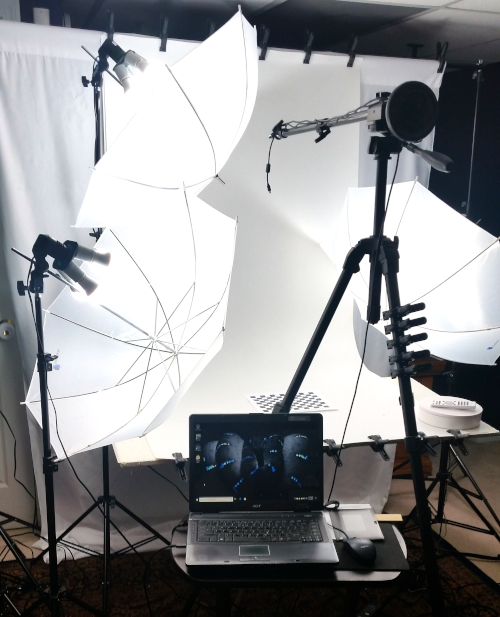
- QSX Digital Ultra Pro Tripod
- Sunpak "Quantaray" Quick-Release Camera Mount
- Glide Gear OH50 Counter-Weighted Overhead Camera Mount
- Ulanzi Heavy-Duty Smartphone Mount
- Sekonic L-308S Flashmate Incident and Reflected Light Exposure Meter
- Limo Studio LMS103 Lighting Kit (See NorthLux™ LED specs below for Continuous Lighting)
- Limo Studio AGG2263 Lighting Kit (See NorthLux™ LED specs below for Continuous Lighting)
- Limo Studio AGG813 4 in 1 Light Socket Splitter Adapter
- NorthLux™ 4003 LED Bulb for Art and Studio (CRI 95, R9 >80, 6500K)
- Limo Studio AGG1112 Backdrop Kit
- Julius Studio JSAG103 6' X 9' White Photo Backdrop Screen
- Selens 40x80 Photography Backdrop (Matte PVC Vinyl Seamless White Background)
- EACHPOLE Heavy Duty Nylon Spring Clamps
- ComXim MT200RL20H 360 Degree Turntable for Product Photography
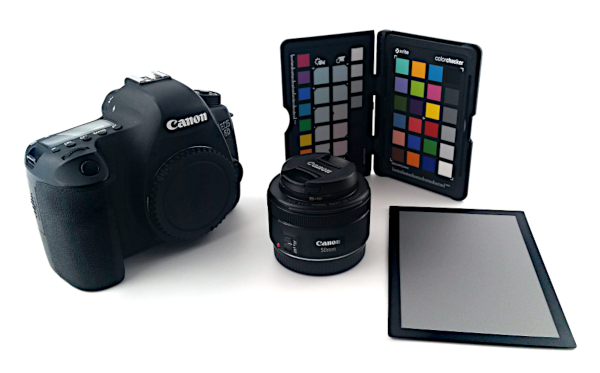
- Canon EOS 6D 20.2MP DSLR Camera (Full-Frame)
[Canon RS-80N3 (Remote Trigger)]
[Canon EF 50mm f/1.8 STM Lens w/ ES-68 Lens Hood]
- X-Rite i1Profiler v1.8.2.8404 / XRD v3.0.17.36 (Monitor Color Calibrator)
- X-Rite ColorChecker Passport v1.1.1
- X-Rite 18% Grey Card, 4x7
- Adobe Lens Profile Creator v1.0.4
- Adobe DNG Converter v11.1.0.112
- Adobe Lightroom 6 (Last Standalone Release)
- Gimp v2.10
PRODUCT RETURNS
- Should you wish to return a product because you are not satisfied with it then please read our Return Policy .
References:
- Planck's Law (en.wikipedia.org/wiki/Planck%27s_law)
- Tubular Luminescence Lamps for General Illumination, Philips Technical Review, vol.6, 65-96, 1941 (http://www.extra.research.philips.com/hera/people/aarts/_Philips%20Bound%20Archive/PTechReview/PTechReview-06-1941-065.pdf)
- The Color of White: Is there a 'preferred' color temperature for the exhibition of works of art?, WAAC Newsletter, vol 21, 3, Sept. 2000 (cool.conservation-us.org/waac/wn/wn21/wn21-3/wn21-308.html)
- Top 4 Things To Consider Before Buying 6500K Daylight LED Bulbs., Waveform Lighting (www.waveformlighting.com/color-matching/top-4-things-to-consider-before-buying-6500k-daylight-led-bulbs)
- www.lrc.rpi.edu, Lighting Research Center
- Practicle Guideline and References for Digital Photographers, Version 1.00, October 21, 2006 (www.fredmiranda.com/forum/WGuidelines.pdf)